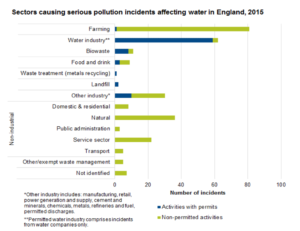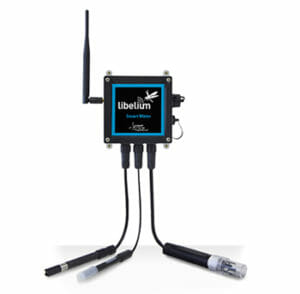
Smart Water solutions use IoT (Internet of Things) technologies to monitor and measure water quality, conserve water supplies and enable cities to function efficiently. In this article, we outline four examples of how Libelium Plug&Sense can be used for Smart Water applications. The following examples demonstrate several implementations of the technology, and we outline how it can be used to enhance decision making, monitor trends and generate alerts.
Smart Water IoT Examples
Chemical Detection in Rivers

In February 2018, the Environment Agency in the UK published the State of the Environment Report: Water which reported a gradual decline in the condition of English rivers. Over 86% of Rivers throughout England failed to achieve good ecological status. The reason for this poor quality was primarily phosphorous and to a lesser extent, nitrates. Water quality issues were the cause of 38% of all fish test failures and 61% of invertebrate test failures in 2015.
Smart Water sensors can detect the presence of chemicals in rivers or watercourses. The presence of these chemicals may be due to run-off, agriculture, manufacturing, landfill and other sources of pollution. Libelium Smart Water solutions can detect a wide range of chemicals and contaminants in water. The measurements taken by the sensors can be transmitted back to the cloud using 4G, LoRA or WIFI. The ultra-low power draw of these units also means they can operate in remote locations running on solar power.
River Floods and Reservoir Levels
The weather has become more predictable in the past few years, with an increasing number of significant meteorological events reported. The growing volatility of our climate has led to increased regional and localised flooding, rivers bursting their banks and storm surges swamping population centres. Conversely, an increasing trend of unseasonably warm weather has pushed drinking water suppliers to the limit. With record-breaking UK temperatures in July 2019 already, some are predicting more heatwaves and the potential for a hosepipe ban in August 2019.
The ability to monitor water levels in real-time offers many benefits to local authorities and utilities. The Libelium Smart Water solution can monitor water levels using innovative ultra-sonic sensors that can report water levels to the nearest centimetre (cm). Data and trends can be analysed, while sudden events (floods or leaks) can trigger automated alerts to notify key personnel.
Fisheries

Commercial fisheries and ponds require optimal water conditions to ensure the fish and wildlife thrive. As with other Smart Water applications, the ability to monitor key metrics such as diluted oxygen, nitrates, pH levels and phosphates are vital. Fish growth is limited in water levels with a pH of less than 6.5 and the death of the fish is almost inevitable at pH less than 4.
Libelium Smart Water technologies can monitor critical parameters and metrics, reporting the data back for review, monitoring and alerting. With flexible communication options including WIFI and 4G – with solar/battery-powered units – the system is perfect for commercial fisheries, fishing ponds and similar environments.
Drinking-Water Quality
Libelium Smart Water systems have been used to great effect throughout the world to monitor the condition of drinking water. IoT technology can be used to monitor rivers, lakes, watercourses, wells and boreholes – ensuring that the water is suitable for human or animal consumption.
The Smart Water system monitors a range of parameters that can be used to assess drinking water quality. Similar to river pollution; drinking water sources can be affected by chemical run-0ff or contamination, waste-water, farming, animal faeces and E-Coli – making it potentially unsafe to drink.
Smart Water IoT solutions can give an indication of drinking water quality and alert authorities in the event the quality drops to an unacceptable level. In Scotland alone, 7% (150,000) households rely on private water supplies. ~12.5% of the Republic of Ireland’s population source their water from ‘private supplies’. Despite modern mains water infrastructure, a significant number of households throughout Europe rely on private supplies – that require rigorous monitoring – which is where IoT Smart Water solutions can help.
Learn more

Manx Technology Group supplies the full range of Libelium IoT Smart Water solutions throughout England, Scotland, Ireland, Isle of Man and the Channel Islands. Not only can we supply the equipment, but we offering pre-sales, configuration and deployment services.
Our software development teams can also be engaged to write reporting and visualisation platforms, or integrate the data into your core business systems.
If you would like to learn more about Smart Water technologies and how IoT can be used to monitor water quality – then speak to our solutions team. They can be reached by calling +44 1624 777837, e-mailing sales@mtg.im or submitting a contact form on our website.
Related reading
- IoT Industry Solutions
- IoT Products and Services
- IoT Case Studies
- Internet of Things and ISO 37122
- Measuring dissolved oxygen with IoT
- Internet of Things (IoT) Applications: Smart Agriculture

